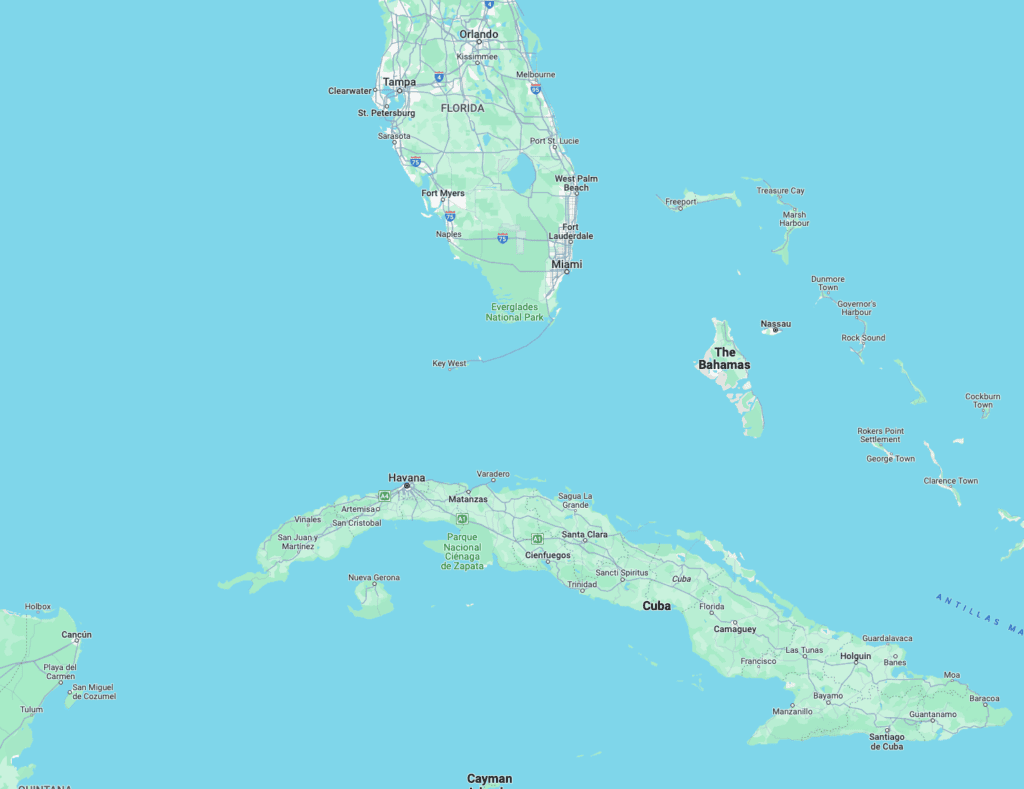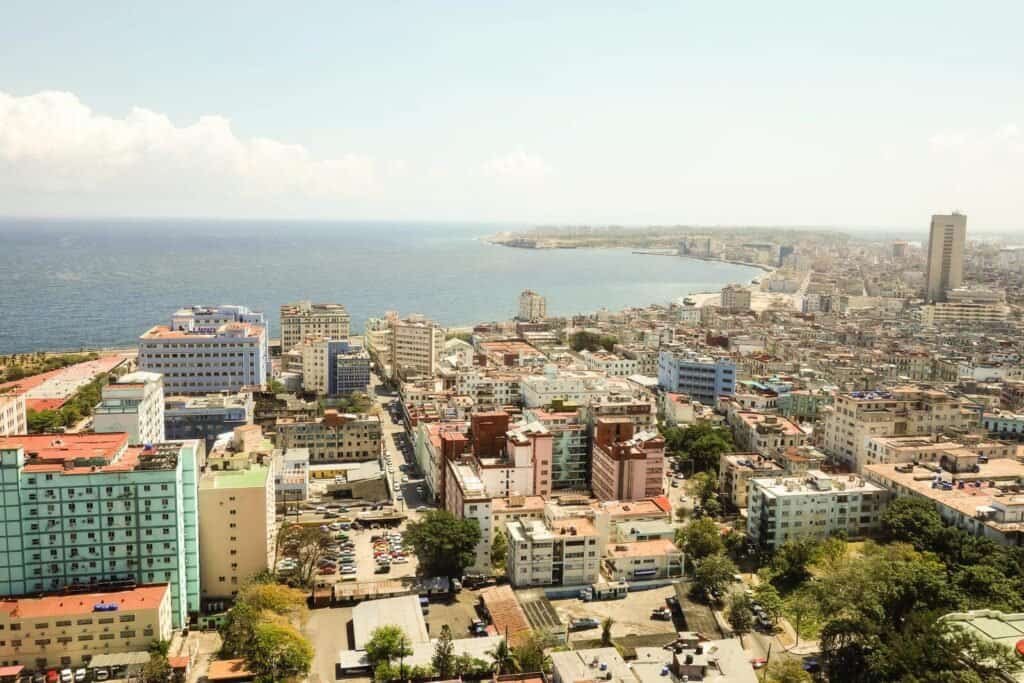The Straight Line: Measuring the Distance from Florida to Cuba
When calculating the straight-line distance, also known as the great-circle distance, between Florida and Cuba, it’s a matter of simple geography. The shortest distance over the earth’s surface from the closest points of these two locales provides the most direct measurement. This distance is approximately 90 miles (145 kilometers) from the southernmost point of Florida, specifically Key West, to the closest Cuban coast, near the town of Caibarién. Straight-line measurements can be deceiving, though, as actual travel routes often cover greater distances due to navigational considerations.
- The Straight Line: Measuring the Distance from Florida to Cuba
- Sailing Through History: The Florida-Cuba Maritime Connection
- Beyond Miles and Kilometers: Understanding Geographical Proximity
- The Havana-Miami Link: A Closer Look at the Cultural and Economic Ties
- Nature's Barrier: The Straits of Florida and Its Oceanic Currents
- Political Waves: How the Distance Has Shaped US-Cuba Relations
- By Air or Sea: Travel Options Between Florida and Cuba
- Fathom the Depths: The Underwater Terrain Between Florida and Cuba
- Charting a Course: Navigational Challenges and Historic Passages
- The Climate Connection: Weather Patterns Across the Florida-Cuba Divide
- Florida to Cuba by the Numbers: Distances from Key Cities and Landmarks
- Technology & Detection: Satellites and Mapping the Florida-Cuba Distance
- Frequently Asked Questions
- Q: How far is Cuba from Florida?
- Q: Can you see Cuba from Key West?
- Q: Is it possible to swim from Cuba to Florida?
- Q: How long does it take to fly from Florida to Cuba?
- Q: What is the nautical distance between Cuba and Florida?
- Q: How can I calculate the distance from Cuba to Florida?
- Q: How long is the driving route from Florida to Cuba?
- Q: What are the Florida Keys in relation to Cuba?
- Q: What is the closest distance between Cuba and Florida?
- Q: Are there any specific trip calculations for traveling between Cuba and Florida?
Sailing Through History: The Florida-Cuba Maritime Connection
The proximity of Florida and Cuba has fostered a significant maritime connection throughout history. Barely 90 miles separate Key West from Havana, leading to a multifaceted relationship encompassing trade, migration, and cultural exchange. Spanish galleons once traversed these waters, later followed by 19th-century steamships and 20th-century ferries. The Florida Straits, infused with narratives of explorers and refugees, have seen countless vessels navigating their currents, etching indelible stories into the fabric of the Florida-Cuba corridor. This bustling maritime route remains a testament to the intertwined fates of these close neighbors.
Beyond Miles and Kilometers: Understanding Geographical Proximity
When considering the proximity of Cuba to Florida, it’s not just about the distance measured in miles or kilometers. Geographical proximity includes various aspects that influence how we perceive the closeness between two places. These aspects encompass:
- Cultural Links: Shared history or cultural ties can make places feel closer despite the physical distance.
- Political Relations: The nature of diplomatic relations can alter perceptions of distance and accessibility.
- Economic Interactions: Trade agreements and economic dependencies can reduce the sense of distance through frequent exchange.
- Transportation Networks: The availability and efficiency of travel routes, including flights and shipping lanes, can significantly affect perceived proximity.
- Environmental Factors: Ocean currents and weather patterns may impact travel time and the sense of nearness between locations.
These factors collectively shape our understanding of how near or far regions are from one another, extending the concept of distance beyond mere numerical values.

The Havana-Miami Link: A Closer Look at the Cultural and Economic Ties
Between Havana and Miami, a vibrant interconnection thrives, underpinned by a mutual heritage and complex histories. Despite the geographic proximity, these waters bridge more than just the gap; they intertwine economies and cultures. Miami serves as the epicenter of the Cuban diaspora, maintaining deep familial and commercial links with Havana. These connections manifest in various sectors, ranging from trade agreements and tourism to the arts and gastronomy. Miami’s Little Havana pulsates with the rhythms and flavors of its counterpart, while remittances from the United States bolster the Cuban economy. The convergence of policies and personal bonds across the Florida Straits continues to mold a dynamic relationship, marked by both challenges and shared cultural identities.
Nature’s Barrier: The Straits of Florida and Its Oceanic Currents
The Straits of Florida, a daunting natural barrier between Cuba and Florida, is much more than a mere expanse of water. This corridor is a bustling marine traffic lane of ocean currents. Notably, it is home to the powerful Gulf Stream. This major Atlantic current originates in the Gulf of Mexico, surges through the straits, and then veils the eastern seaboard of the United States. The Gulf Stream significantly influences both the climate and the maritime conditions in this region. Remarkably, its intense speed and force create a potent maritime boundary, complicating navigation and swimming across this seemingly short span. The straits thus stand as a testament to the complex interplay between proximity and natural forces at the edge of these two landmasses.
Political Waves: How the Distance Has Shaped US-Cuba Relations

Despite the short geographic distance between the US and Cuba, their political estrangement lasted for over half a century. Political ideology has been a significant barrier, with Cuba’s embrace of communism during the Cold War leading to a US embargo in 1960, which remained largely in effect until a thaw began in 2014. The proximity, paradoxically, has made the ideological divide more pronounced, as the US sought to prevent the spread of communism in its hemisphere. Incidents like the Cuban Missile Crisis of 1962 further intensified bilateral tensions. Migration waves, including the Mariel boatlift, have also been a function of this complex relationship, as political and economic discontent in Cuba have periodically pushed Cubans to make the perilous journey across the strait.
By Air or Sea: Travel Options Between Florida and Cuba
Travelers have two primary options to traverse the 90 miles separating Florida and Cuba, namely air and sea. Multiple airlines operate direct flights from cities like Miami and Fort Lauderdale to Havana, ensuring a quick journey of about an hour. Conversely, sea travel from Florida to Cuba is available through various cruise lines. These cruises offer a more leisurely pace, typically spanning a few days. While ferry services were once a mode of transport, they are currently infrequent and subject to the evolving US-Cuba policies. Prospective visitors should verify the latest travel regulations before planning their trip.
Fathom the Depths: The Underwater Terrain Between Florida and Cuba
Beneath the waters that connect Florida and Cuba lies an intricate abyssal plain, marked by the profound Straits of Florida. This channel, which serves as a submarine highway for diverse marine life, showcases a range of undersea features including:
- Spectacular coral reefs teeming with aquatic biodiversity
- The precipitous drop of the continental shelf defining the edge of Florida’s landmass
- Varied underwater topography comprising slopes, basins, and oceanic trenches
- The Gulf Stream, a mighty and warm ocean current, coursing through the straits
This submarine landscape not merely divides the two landmasses but also connects them through a shared environmental heritage.

Charting a Course: Navigational Challenges and Historic Passages
Navigational planning from Florida to Cuba is rife with challenges, primarily due to the unpredictable Gulf Stream and tricky weather patterns. Seafarers must plot their course carefully, considering current speeds that can reach 5 miles per hour. Historically, this passage has been treacherous yet alluring, marking the endeavors of explorers and migrants alike. Key waypoints often include the Straits of Florida and the historic Old Bahama Channel, routes that have seen the passage of ships since the times of Columbus. Skilled navigation and respect for the powerful natural forces at play remain crucial for the successful traversal of these 90 miles of sea.
The Climate Connection: Weather Patterns Across the Florida-Cuba Divide
Despite the short distance separating Florida and Cuba, climatic nuances exist due to oceanic influences and local weather systems. Both regions experience tropical climates, yet subtle differences are noteworthy:
- Florida encounters more temperate influences, with a propensity for cold fronts descending from the north during winter months, which can bring cooler temperatures and storms.
- Conversely, Cuba’s weather is fairly consistent, with the island’s position in the Caribbean fostering a more stable, warmer environment year-round.
- Hurricane season highlights the connected weather systems, as tropical cyclones often move from the southeastern Caribbean toward Florida, underlining the shared meteorological dynamics.
- Seasonal changes in prevailing winds can affect local weather, with the easterly trade winds typically driving moist air across both geographies.
The interplay of regional weather patterns emphasizes the close climate connection between Florida and Cuba.
Florida to Cuba by the Numbers: Distances from Key Cities and Landmarks
Travelers curious about the proximity of Cuba to Florida can gauge the distance with these figures:
- Miami to Havana: Roughly 228 miles (367 kilometers) separate Miami from Havana, across the Straits of Florida.
- Key West to Havana: A mere 90 miles (145 kilometers) lie between Key West and Havana, making it the shortest route from the U.S. mainland to Cuba.
- Fort Lauderdale to Santiago de Cuba: The distance from Fort Lauderdale to Santiago de Cuba is about 515 miles (830 kilometers).
- Cape Canaveral to Cienfuegos: This route stretches approximately 350 miles (563 kilometers) across the sea.
These distances underscore the close yet distinct relationship between the shores of Florida and Cuba.
Technology & Detection: Satellites and Mapping the Florida-Cuba Distance
Advancements in satellite technology have enhanced our ability to map and measure the distance between geographic points with precision. For estimating the distance between Florida and Cuba, various satellites equipped with high-resolution imaging and radar altimetry are employed. Global Positioning System (GPS) satellites play a crucial role by providing precise coordinates that help in calculating the span separating these land masses. Geospatial analysis software takes these coordinates and generates accurate maps, allowing cartographers to delineate the proximities between shores. This satellite data ensures that the Florida-Cuba distance is monitored with an accuracy previously unattainable, contributing vital information for navigation and international relations.
Frequently Asked Questions
Q: How far is Cuba from Florida?
A: The distance between Cuba and Florida is approximately 90 miles at its closest point, which is between Key West, Florida and Havana, Cuba.
Q: Can you see Cuba from Key West?
A: Yes, on a clear day, it is possible to see Cuba from Key West, especially from the higher points on the island.
Q: Is it possible to swim from Cuba to Florida?
A: It is possible to swim from Cuba to Florida, and the most famous successful swim was accomplished by Diana Nyad in 2013, covering approximately 110 miles in 53 hours.
Q: How long does it take to fly from Florida to Cuba?
A: On average, a direct flight from Florida to Cuba takes around 1 to 2 hours, depending on the specific departure and arrival cities.
Q: What is the nautical distance between Cuba and Florida?
A: The nautical distance between Cuba and Florida is approximately 103 miles, which is a common measurement used for sea travel.
Q: How can I calculate the distance from Cuba to Florida?
A: You can use online distance calculators or mapping tools that provide the option to measure the distance between two points, such as the distance between Cuba and Florida.
Q: How long is the driving route from Florida to Cuba?
A: There is no direct driving route from Florida to Cuba due to the geographical separation by the Straits of Florida. The distance can only be covered by sea or air travel.
Q: What are the Florida Keys in relation to Cuba?
A: The Florida Keys are a coral cay archipelago located off the southern coast of Florida, and they are the closest point in the United States to Cuba.
Q: What is the closest distance between Cuba and Florida?
A: The closest distance between Cuba and Florida is around 90 miles, specifically between Key West, Florida and Havana, Cuba.
Q: Are there any specific trip calculations for traveling between Cuba and Florida?
A: Yes, you can find trip calculations, including air line distance, flight time, nautical miles, and driving distance, for travel between Cuba and Florida on various travel planning platforms.